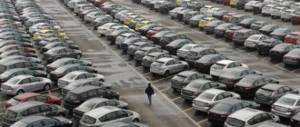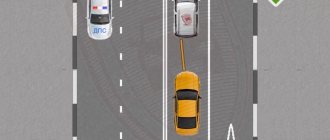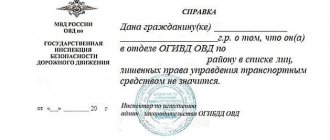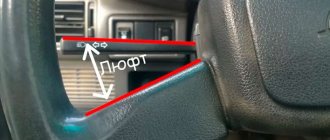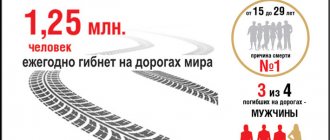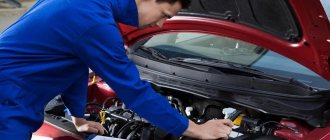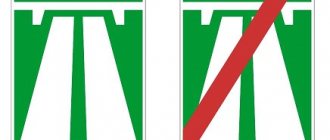Sign 5.11.1 “Road with a lane for route vehicles”
The sign “Road with a lane for route vehicles” is used to designate a road on which the movement of route vehicles, as well as other vehicles allowed to move along with route vehicles, is carried out along a specially designated lane towards the general flow of vehicles.
Sign 5.11.1 “Road with a lane for route vehicles” is installed at the beginning of the road section above the carriageway or on both sides of the road. Repeated sign 5.11.1 is installed after intersections with complex layouts.
You need to pay attention to the fact that the dedicated lane on the road marked with sign 5.11.1 is oncoming! Accordingly, sanctions for driving on it can be applied as for driving in the oncoming lane (fines for this violation are at the end of the article).
Which driver stopped correctly to unload passengers?
| 1. | Only A. |
| 2. | Only in. |
| 3. | A and B. |
| 4. | B and V. |
Answer
- On the left side of one-way roads (sign “One-way road”) in populated areas, stopping and parking of vehicles is allowed (where driver “A” stopped).
- On roads with a lane for route vehicles (sign, markings in the form of the letter “A”), driving and stopping other vehicles in this lane (where driver “B” stopped) is prohibited.
- Passengers should board and disembark from the sidewalk or curb, and not in the middle of the roadway where driver “B” stopped.
Therefore, only driver “A” did not violate.
Signs 5.13.1, 5.13.2 “Exit onto a road with a lane for route vehicles”
Signs 5.13.1 and 5.13.2 “Exit onto a road with a lane for route vehicles” are used to indicate exits to the road marked with sign 5.11.1 and are installed in front of all side entrances.
Signs 5.13.1 and 5.13.2 indicate that there is a dedicated lane for route vehicles on the road being crossed. Accordingly, after sign 5.13.1, all vehicles that are not allowed to move on the dedicated lane are prohibited from turning left, and after sign 5.13.2 they are prohibited from turning right.
If at the point of exit to the road there are several signs on one support, signs 5.13.1, 5.13.2 are usually located above other signs, i.e. above all, but this does not always happen.
It is permissible not to install signs at exits from adjacent territories if it is possible to enter these territories only from a road with a lane for route vehicles.
Who can ride in the bus lane?
Paragraph 18.2 of the traffic rules contains a list of vehicles that can enter the dedicated lane:
- Route vehicles (buses, trolleybuses, minibuses).
- School buses.
- Passenger taxis.
- Buses heavier than 5 tons, which are included in special lists approved by the executive authorities of Moscow, St. Petersburg or Sevastopol.
- Cyclists.
Please note that school buses, taxis, scheduled buses and cyclists may not always use the bus lane. Consider the following situation:
Look at the right side of the picture. A sign 3.1 (brick) is installed above the dedicated lane , prohibiting entry into this lane. This sign does not apply to fixed-route vehicles, but it prohibits traffic in the designated lane for all others.
Fine for driving under a brick sign
Therefore, if you are riding, for example, a bicycle, then before entering the dedicated lane, make sure that additional signs do not prohibit this.
In addition, the list of exceptions does not include :
- Car sharing cars (they are neither taxis nor route vehicles).
- Motorcycles.
- Mopeds and scooters.
- Buses for transporting children that are not school buses.
Sign 5.14 “Lane for route vehicles”
Sign 5.14 “Lane for route vehicles” is used to designate the lane along which route vehicles move alongside the general flow of vehicles. This strip is called a “dedicated strip”.
The sign “Lane for route vehicles” is installed at the beginning of the lane above this lane (on top), and if it is the far right, it is allowed to install the sign to the right of the lane (on the side of the roadway).
Sign 5.14 is repeated at each intersection throughout the entire section of the road where the traffic of route vehicles is organized along this lane.
A fine will be imposed for vehicles entering the designated lane without permission (at the end of the article).
New “beneficiaries” on the MTS lane
We continue to get acquainted with the changes to the Traffic Rules, which are being introduced from December 14, 2021. In this article we will look at the changes being made to the section on the priority of route vehicles.
- Traffic rules changes for cyclists;
- New places where stopping and parking are prohibited;
- New “beneficiaries” on the MTS band - this article;
- Changes when moving through customs (coming soon);
Vehicles that can use the MTS lane for driving are specified in paragraph 18.2 of the Traffic Rules.
| Clause 18.2 - old version |
| 18.2. On roads with a lane for fixed-route vehicles, marked with signs 5.11, 5.13.1, 5.13.2, 5.14, the movement and stopping of other vehicles is prohibited (except for school buses and vehicles used as passenger taxis, as well as cyclists - in case if the lane for route vehicles is located on the right) on this lane. |
Let's start with the fact that the legislator finally saw that it is not enough to allow traffic on the MTS lane, but it is also necessary to give it the opportunity to continue after the intersection. To do this, it is necessary to deviate from some of the requirements of road signs.
| Rules for driving on the MTS lane |
| Drivers of vehicles permitted to drive in lanes for fixed-route vehicles, when entering an intersection from such a lane, may deviate from the requirements of road signs 4.1.1 - 4.1.6, 5.15.1 and 5.15.2 to continue driving along such a lane. |
Please note only to continue driving in the MTS lane and only when driving in the MTS lane. You cannot ignore these signs when changing to the MTS lane after an intersection and when changing from the MTS lane to the general lane.
Invalid signs when continuing to move along the MTS lane after the intersection
As before, all “preferential” vehicles, except route vehicles, are unable to enter the MTS lane allocated for driving against the general flow. Before entering such a lane, a sign 3.1 is installed, commonly known as “Brick”. Turning from an intersecting road into such a lane is also prohibited by signs not included in the exceptions.
The road signs also have a change in description.
| "5.11.1. "Road with a lane for route vehicles" |
| A road on which vehicles permitted to move in lanes for route vehicles move in a specially designated lane towards the general flow of vehicles |
| 5.14 “Lane for route vehicles” |
| A specially allocated lane along which vehicles allowed to move in lanes for route vehicles move in the same direction as the general flow of vehicles |
- Next, let's look at the new version of clause 18.2 and below we will conclude who has the right to drive on the dedicated MTS lane.
- school buses;
- vehicles used as passenger taxis;
- vehicles that are used to transport passengers have, with the exception of the driver's seat, more than 8 seats, the technically permissible maximum weight of which exceeds 5 tons, the list of which is approved by the executive authorities of the constituent entities of the Russian Federation - the cities. Moscow, St. Petersburg and Sevastopol;
- vehicles that are transported during the period from February 23 to March 14, 2021, as determined by the Government of the Krasnoyarsk Territory in agreement with the Ministry of Transport of the Russian Federation, the Ministry of Internal Affairs of the Russian Federation and the autonomous non-profit organization “Executive Directorate of the XXIX World Winter Universiade 2021 in Krasnoyarsk » client groups (representatives of national university sports federations, participants in sports competitions, representatives of the International University Sports Federation (FISU), representatives of the media, technical officials, other persons taking part in the events of the XXIX World Winter Universiade 2021 in Krasnoyarsk) , in the presence of an accreditation certificate issued by the autonomous non-profit organization “Executive Directorate of the XXIX World Winter Universiade 2021 in Krasnoyarsk
| Clause 18.2 - new edition. Part 1, traffic allowed |
| 18.2. On roads with a lane for route vehicles, marked with signs 5.11.1, 5.13.1, 5.13.2 and 5.14, the movement and stopping of other vehicles in this lane is prohibited, with the exception of: |
Everything is clear, school buses and taxis have long been able to move along the MTS lane, the following.
| Clause 18.2 - new edition. Part 2, traffic allowed |
This change comes into force simultaneously with changes to the Law “On Road Safety”, which states:
The list of such vehicles and subsequent changes to it must be officially published in the manner established by the legislation of the federal cities of Moscow, St. Petersburg and Sevastopol, no later than thirty days before the date of entry into force of this list (changes to the list).
These changes will be in effect from December 20, 2021, and based on these changes, a list of vehicles that are also allowed to drive on the MTS lane will be published later.
| Clause 18.2 - new edition. Part 3, traffic allowed |
It is not entirely clear why such a “sheet” is needed in the traffic rules and why the validity period is not indicated in one document, but nevertheless it will be in the traffic rules from December 14, 2021. The exception to this paragraph will be in a separate government resolution. Persons involved in the Universiade will be able to drive on MTS lanes in Krasnoyarsk, provided they have an accreditation certificate, from February 23 to March 14, 2021.
| Clause 18.2 - new edition. Part 4, traffic allowed |
| Cyclists are allowed on lanes for fixed-route vehicles if such a lane is located on the right. |
Slightly modified paragraph. Cyclists can use the MTS lane, provided they can move along the edge of the roadway.
Do not forget the peculiarities of driving along the MTS lane using the example of a passenger taxi.
Sign 5.14.2 “Lane for cyclists”
Sign 5.14.2 “Lane for cyclists” is used to designate a lane along which the movement of bicycles and mopeds is permitted. The movement of bicycles and mopeds is carried out in a direction similar to the general flow of vehicles.
The “Lane for Bicycles” sign is installed at the beginning of the lane above this lane (on top), or to the right of the lane (on the side of the roadway).
For driving into a lane marked with sign 5.14.2 “Lane for cyclists,” as well as for driving vehicles other than bicycles and mopeds in this lane, Article 12.15 Part 2 provides for a fine of 2,000 rubles as of the date of publication.
Fines for leaving the lane for route vehicles
Entering a dedicated lane (for route vehicles) in a prohibited case can occur both in the same direction and in the opposite direction. Sanctions for these violations will vary.
For leaving the allocated lane in the same direction - a fine of 1,500 rubles. (in Moscow or St. Petersburg - a fine of 3,000 rubles).
For entering a designated lane in the opposite direction while avoiding an obstacle, the fine is 1,000–1,500 rubles.
For entering the allocated lane in the oncoming direction for any reason other than avoiding an obstacle - a fine of 5,000 rubles. or deprivation of rights for up to six months. In case of repeated violation - deprivation of rights for 1 year or a fine of 5,000 rubles.
A complete list of road signs with special requirements with brief comments (explanations) on the website is posted in Appendix 1 of the Traffic Regulations.
Navigation through a series of articles<<Signs of special regulations 5.5 - 5.10Signs for lane directions >>
Should the MTS lane be taken into account for the purpose of applying the norm of clause 9.4 of the traffic rules?
Clause 9.4 of the Traffic Rules has long raised a number of questions among both road users and law enforcement officers. One of these is the question of the relevance of the MTS lane (not separated by a dividing strip, of course) to the requirements of this standard.
Let us present the contents of paragraph. 3 clause 9.4 of the Traffic Rules:
three or more lanes for traffic in a given direction , the leftmost lane is allowed to occupy only in heavy traffic, when other lanes are occupied, as well as for turning left or making a U-turn, and for trucks with a permissible maximum weight of more than 2.5 t - only for turning left or making a U-turn.
From the literal, textual expression of this paragraph it follows that the lane for route vehicles (MTS) is taken into account by this norm. In this case, for example, in the photo below, passenger cars in the far left lane (in the same direction) are violators (paragraph 3 of clause 9.4 of the Rules).
Formalism and literalism in the interpretation of the point under study lead to a dead end and give rise to obvious nonsense and uncertainty. Clause 9.4 of the Traffic Regulations should be interpreted restrictively. A teleological reduction of the norm is necessary.
Based on the doctrine of priority of content over form, the MTS lane, which is a traffic lane with a special (special) legal regime, does not fall under the jurisdiction of clause 9.4 of the Traffic Regulations.
Objectively, those privileged road users who are allowed to occupy the lane for MTS are also exempt from the requirements of this paragraph of the Rules (clause 18.2 of the Traffic Regulations).
Otherwise, this legal structure makes virtually any traffic route with dedicated lanes meaningless.
For example, the driver of a passenger taxi (or school bus) on a four-lane road (in a given direction), if there is an extreme left lane for MTS, has the right to drive in a dedicated lane and provided that the right, ordinary lanes are free.
And a three-way version.
The above arguments comply with the principle of lex specialis derogat generali (in the context of a conflict between clauses 9.4 and 18.2 of the Traffic Regulations).
In SP 396.1325800.2018 Streets and roads of populated areas. Rules of urban planning (with Amendment No. 1) a dedicated traffic lane for public ground passenger transport is defined as a traffic lane on the main roadway , allocated by markings or structurally and intended exclusively for the movement of public ground passenger transport (clause 3.1.2 SP).
If necessary, it is allowed to separate designated traffic lanes using flexible barriers and/or deliminators (clause 6.8 of the SP).
It is advisable to arrange dedicated traffic lanes for NPTOP on streets and roads of citywide importance with the number of traffic lanes of 3 or more in one direction. On main streets with one-way traffic, it is allowed to arrange a dedicated lane for NPTOP with the organization of traffic towards the general flow of vehicles (clause 6.8a of the SP).
Here it is appropriate to “load” paragraph f of Art. 1 of the Convention on Road Traffic : “on a carriageway where the outer lane or outer lanes or cycle tracks are designated for the passage of certain vehicles, the term “ edge of the carriageway ” means for other road users the edge of the remainder of the road.”
I will separately dwell on the Decree of the Moscow Government of September 27, 2011 N 453-PP “ On the organization of dedicated lanes for the movement of route vehicles .”
According to clause 1.2 of Appendix 2 of the said Resolution:
“ Dedicated lane for the movement of route vehicles ” (hereinafter referred to as the dedicated lane) is a section of the road intended for the movement of route vehicles, marked with appropriate technical means of organizing traffic (road signs, road markings) in accordance with GOST R 52289-2004 “Technical means of traffic management."
Thus, the lane for MTS is a separate section of the road with a special legal regime (clause 18.2 of the traffic rules), its own infrastructure (and a very extensive one).
Sections of the road are repeatedly mentioned in GOSTs regarding reversible lanes, one-way roads, traffic roads, etc., but to identify the nature of these sections of the road with the section allocated for a lane for MTS is methodologically incorrect, and in the context of the issue under consideration, it is irrelevant.
According to clause 1.3 of Appendix 2 to Moscow Government Decree No. 453-PP dated September 27, 2011, the dedicated band infrastructure may include:
1) road markings;
2) road signs and information boards;
3) drive-in pockets at stopping points with extended landing areas;
4) special technical means of photo and video recording of administrative offenses, integrated into the intelligent transport system;
5) settling and turning areas (SRP), intended for bus rapid transit systems (BAS) and located in close proximity to the dedicated lane at the end of the BAS route route.
6) terminal stations;
7) intercepting parking lots.
As we can see, the MTS lane is distinguished from other sections of the road by a sovereign legal regime, technological arrangement and extensive infrastructure, which are unusual for other, ordinary traffic lanes.
SP 396.1325800.2018 and the Regulations for the creation and operation of dedicated lanes for the movement of route vehicles logically “deduce” the lane for MTS into a separate section of the road and, accordingly, this lane is not objectively taken into account for the purposes of clause 9.4 of the traffic rules.
Yes, Resolution of the Moscow Government dated September 27, 2011 N 453-PP is a legal regulation of a separate constituent entity of the Russian Federation, but this resolution would be used as a basis for resolving such issues, including by analogy - it fills many gaps.
When designing lanes for MTS, it is advisable to separate the lane for route vehicles from the general flow of vehicles with a dividing strip , marked by marking lines 1.2 and 1.16.1 or 1.16.2.
According to clause 6.2.4 of GOST R 52289-2019, marking 1.2 can be used to designate a dividing strip with a width of at least 0.5 m, intended to separate a lane for cyclists or a lane for route vehicles from the general flow of vehicles.
Marking 1.16.1 may be used to indicate a dividing strip intended to separate a lane for cyclists or a lane for route vehicles from the general flow of oncoming vehicles, 1.16.2 - passing vehicles or parking (clause 6.2.19 GOST R 52289-2019 ).
Thus, the arsenal of current GOSTs contains all the necessary technical means of organizing traffic, the use of which eliminates such collisions.
